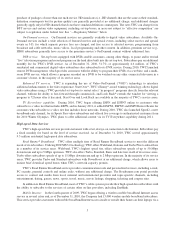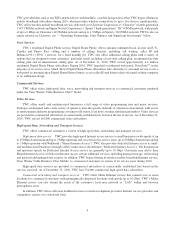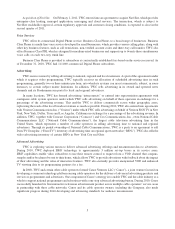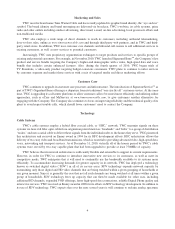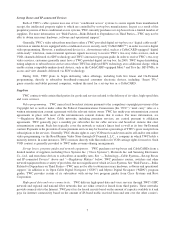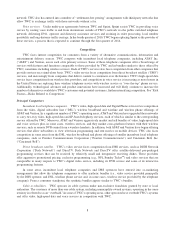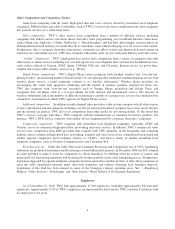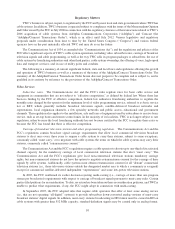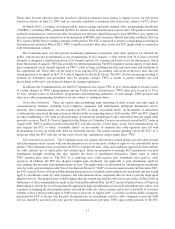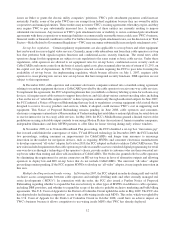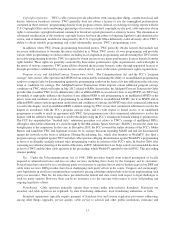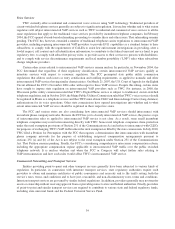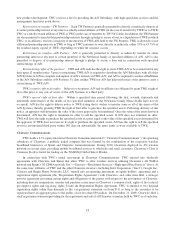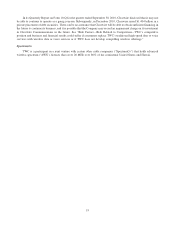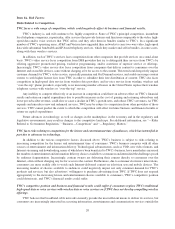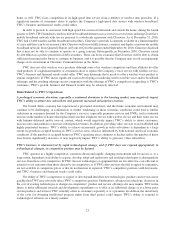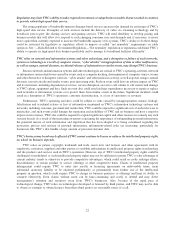Time Warner Cable 2010 Annual Report Download - page 24
Download and view the complete annual report
Please find page 24 of the 2010 Time Warner Cable annual report below. You can navigate through the pages in the report by either clicking on the pages listed below, or by using the keyword search tool below to find specific information within the annual report.issues an Order or grants the electric utility companies’ peititions, TWC’s pole attachment payments could increase
materially. Finally, some of the poles TWC uses are exempt from federal regulation because they are owned by utility
cooperatives and municipal entities. These entities may not renew TWC’s existing agreements when they expire, and they
may require TWC to pay substantially increased fees. A number of these entities are currently seeking to impose
substantial rate increases. Any increase in TWC’s pole attachment rates or inability to secure continued pole attachment
agreements with these cooperatives or municipal utilities on commercially reasonable terms could cause TWC’s business,
financial results or financial condition to suffer. For further discussion of pole attachment rates, see the discussion in “Risk
Factors—Risks Related to Government Regulation—TWC may encounter substantially increased pole attachment costs.”
Set-top box regulation. Certain regulatory requirements are also applicable to set-top boxes and other equipment
that can be used to receive digital video services. Currently, many cable subscribers rent from their cable operator a set-top
box that performs both signal-reception functions and conditional-access security functions. The rental rates cable
operators charge for this equipment are subject to rate regulation to the same extent as basic cable service. Under these
regulations, cable operators are allowed to set equipment rates for set-top boxes, conditional-access security cards or
CableCARDs and remote controls on the basis of actual capital costs, plus an annual after-tax rate of return of 11.25%, on
the capital cost (net of depreciation). In 1996, Congress enacted a statute requiring the FCC to pass rules fostering the
availability of set-top boxes. An implementing regulation, which became effective on July 1, 2007, requires cable
operators to cease placing into service new set-top boxes that have integrated security functions. DBS operators are not
subject to this requirement.
In December 2002, cable operators and consumer-electronics companies entered into a standard-setting agreement
relating to reception equipment that uses a CableCARD provided by the cable operator to receive one-way cable services.
To implement the agreement, the FCC adopted regulations that (i) establish a voluntary labeling system for such one-way
devices; (ii) require most cable systems to support these devices; and (iii) adopt various content-encoding rules, including
a ban on the use of “selectable output controls” to direct program content only through authorized outputs. In June 2007,
the FCC initiated a Notice of Proposed Rulemaking that may lead to regulations covering equipment sold at retail that is
designed to receive two-way products and services, which, if adopted, could increase TWC’s cost in supporting such
equipment. This Notice of Proposed Rulemaking remains pending. In June 2008, cable operators and consumer-
electronics companies entered into a Memorandum of Understanding that establishes a national platform for retail devices
to receive interactive (or two-way) cable services. In May 2010, the FCC’s Media Bureau granted a limited waiver of the
prohibition on using selectable output controls to encourage Motion Picture Association of America member companies,
independent filmmakers and their MVPD partners to offer films for home viewing during early release windows.
In November 2009, in its National Broadband Plan proceeding, the FCC identified a set-top box “innovation gap”
that it stated could hinder the convergence of video, TV and IP-based technology. In December 2009, the FCC launched
two proceedings, seeking comment on improvements for CableCARDs and longer term measures to encourage
innovation in the market for navigation devices, such as requiring MVPDs and consumer electronics manufacturers
to develop a universal “all-video” adapter. In October 2010, the FCC adopted an Order to address CableCARD issues. The
new rules included requirements that cable operators provide reasonable access to switched digital programming for retail
one-way devices through a technology of the operator’s choice, provide credits to customers who use their own retail set-
top boxes rather than renting and allow self-installation of CableCARDs. The Order also granted relief to cable operators
by eliminating the requirement for certain connectors on HD set-top boxes in favor of alternative outputs and allowing
operators to deploy low-end HD set-top boxes that do not include CableCARDs. The universal “all-video” adapter
proceeding remains pending. If the FCC requires MVPDs to develop an “all-video” adapter, it may impede innovation in
this area.
Multiple dwelling units and inside wiring. In November 2007, the FCC adopted an order declaring null and void all
exclusive access arrangements between cable operators and multiple dwelling units and other centrally managed real
estate developments (“MDUs”). In connection with the order, the FCC also issued a Further Notice of Proposed
Rulemaking regarding whether to expand the ban on exclusivity to other types of MVPDs in addition to cable operators,
including DBS providers, and whether to expand the scope of the rules to prohibit exclusive marketing and bulk billing
agreements. The U.S. Court of Appeals for the District of Columbia Circuit upheld the order in May 2009. The FCC also
has adopted rules facilitating competitors’ access to the cable wiring inside such MDUs. This order, which was upheld by
the U.S. Court of Appeals for the District of Columbia Circuit in October 2008, could have an adverse impact on
TWC’s business because it allows competitors to use wiring inside MDUs that TWC has already deployed.
12



